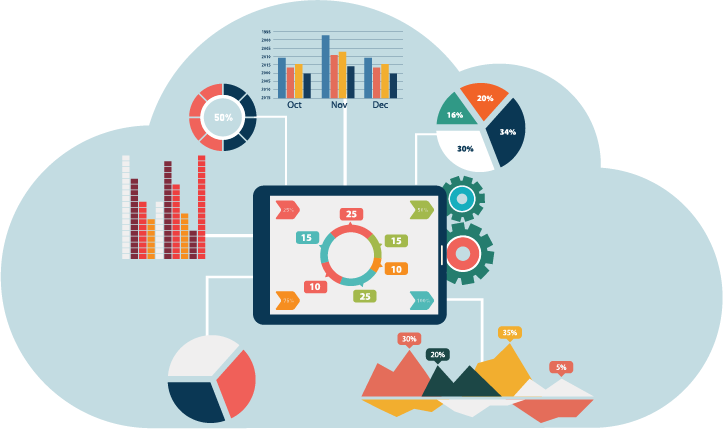Hadoop Big Data Analytics: Smart Data Analytics Solutions
Hadoop Big Data Analytics has revolutionized the way organizations handle vast amounts of data, making it possible to store, process, and analyze data at an unprecedented scale and speed. At its core, Hadoop is an open-source framework that allows for the distributed processing of large data sets across clusters of computers using simple programming models. Its architecture is designed to scale from a single server to thousands of machines, each offering local computation and storage, making it ideal for handling big data.
One of the most significant advantages of Hadoop Big Data Analytics is its ability to manage and analyze data from diverse sources. With the explosion of data generated by social media, sensors, and various digital platforms, organizations are inundated with vast amounts of structured and unstructured data. Hadoop's Hadoop Distributed File System (HDFS) provides high-throughput access to application data, allowing businesses to efficiently store and retrieve large data sets. This capability is crucial for industries like finance, healthcare, and retail, where data-driven insights are essential for making informed decisions.
Hadoop's MapReduce programming mo zdel is another cornerstone of its power in big data analytics. MapReduce simplifies the process of writing applications that process vast amounts of data in parallel on large clusters of commodity hardware. The model divides the data into independent chunks that are processed in a completely parallel manner, thereby significantly speeding up the data processing time. This parallel processing capability is particularly beneficial for performing complex analyses, such as machine learning algorithms, data mining, and predictive analytics, which require substantial computational power and resources.
Moreover, Hadoop Big Data Analytics offers cost-effective solutions for data storage and processing. Traditional data warehousing solutions can be prohibitively expensive due to the costs associated with hardware, software, and maintenance. Hadoop, on the other hand, leverages commodity hardware and open-source software, significantly reducing the overall cost of ownership. This cost efficiency enables organizations of all sizes to adopt big data analytics, democratizing access to advanced data insights.
Hadoop's ecosystem includes a variety of tools and technologies that further enhance its capabilities. Apache Hive, for example, provides a SQL-like interface for querying data stored in Hadoop, making it easier for analysts to extract valuable insights without deep programming knowledge. Apache Pig offers a high-level platform for creating MapReduce programs used with Hadoop. Apache Spark, another integral part of the Hadoop ecosystem, provides an in-memory processing engine that enhances the speed and efficiency of big data processing tasks.
Despite its numerous advantages, Hadoop Big Data Analytics does come with challenges. Managing and maintaining a Hadoop cluster requires specialized skills and expertise. Additionally, ensuring data security and privacy is paramount, given the sensitivity of the information processed. Nevertheless, the continuous advancements in Hadoop technologies and the growing ecosystem of tools and support are addressing these challenges, making Hadoop an indispensable tool for modern data analytics.
In conclusion, Hadoop Big Data Analytics has transformed the landscape of data processing and analysis, providing organizations with the tools and capabilities to harness the power of big data. Its scalability, cost-efficiency, and robust ecosystem make it an essential framework for businesses looking to gain a competitive edge through data-driven insights. As the volume of data continues to grow, Hadoop's role in big data analytics is set to become even more pivotal, driving innovation and efficiency across various industries.
https://www.marketdigits.com/hadoop-big-data-analytics-market Hadoop Big Data Analytics: Smart Data Analytics Solutions
Hadoop Big Data Analytics has revolutionized the way organizations handle vast amounts of data, making it possible to store, process, and analyze data at an unprecedented scale and speed. At its core, Hadoop is an open-source framework that allows for the distributed processing of large data sets across clusters of computers using simple programming models. Its architecture is designed to scale from a single server to thousands of machines, each offering local computation and storage, making it ideal for handling big data.
One of the most significant advantages of Hadoop Big Data Analytics is its ability to manage and analyze data from diverse sources. With the explosion of data generated by social media, sensors, and various digital platforms, organizations are inundated with vast amounts of structured and unstructured data. Hadoop's Hadoop Distributed File System (HDFS) provides high-throughput access to application data, allowing businesses to efficiently store and retrieve large data sets. This capability is crucial for industries like finance, healthcare, and retail, where data-driven insights are essential for making informed decisions.
Hadoop's MapReduce programming mo zdel is another cornerstone of its power in big data analytics. MapReduce simplifies the process of writing applications that process vast amounts of data in parallel on large clusters of commodity hardware. The model divides the data into independent chunks that are processed in a completely parallel manner, thereby significantly speeding up the data processing time. This parallel processing capability is particularly beneficial for performing complex analyses, such as machine learning algorithms, data mining, and predictive analytics, which require substantial computational power and resources.
Moreover, Hadoop Big Data Analytics offers cost-effective solutions for data storage and processing. Traditional data warehousing solutions can be prohibitively expensive due to the costs associated with hardware, software, and maintenance. Hadoop, on the other hand, leverages commodity hardware and open-source software, significantly reducing the overall cost of ownership. This cost efficiency enables organizations of all sizes to adopt big data analytics, democratizing access to advanced data insights.
Hadoop's ecosystem includes a variety of tools and technologies that further enhance its capabilities. Apache Hive, for example, provides a SQL-like interface for querying data stored in Hadoop, making it easier for analysts to extract valuable insights without deep programming knowledge. Apache Pig offers a high-level platform for creating MapReduce programs used with Hadoop. Apache Spark, another integral part of the Hadoop ecosystem, provides an in-memory processing engine that enhances the speed and efficiency of big data processing tasks.
Despite its numerous advantages, Hadoop Big Data Analytics does come with challenges. Managing and maintaining a Hadoop cluster requires specialized skills and expertise. Additionally, ensuring data security and privacy is paramount, given the sensitivity of the information processed. Nevertheless, the continuous advancements in Hadoop technologies and the growing ecosystem of tools and support are addressing these challenges, making Hadoop an indispensable tool for modern data analytics.
In conclusion, Hadoop Big Data Analytics has transformed the landscape of data processing and analysis, providing organizations with the tools and capabilities to harness the power of big data. Its scalability, cost-efficiency, and robust ecosystem make it an essential framework for businesses looking to gain a competitive edge through data-driven insights. As the volume of data continues to grow, Hadoop's role in big data analytics is set to become even more pivotal, driving innovation and efficiency across various industries.
https://www.marketdigits.com/hadoop-big-data-analytics-market





